The sustainability problem of solar power: end-of-life strategies for the off-grid sector
17 May 2019, Dr. Silvia Emili, Category: All insights, News, Tags: Africa, business models, circular economy, design, design principles, e-waste, energy, innovation, low carbon, PAYGo, solar power, sustainability, technology
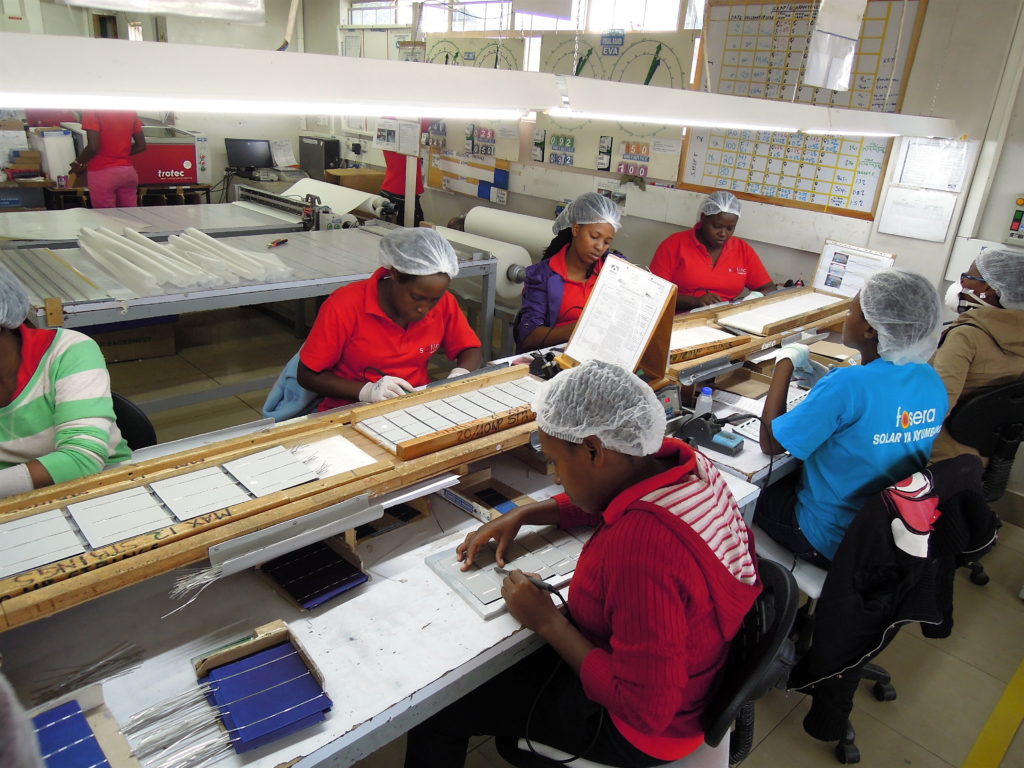
9 minute read.
Solar power and its waste problem
Solar power is electrifying most of the developing world, with a number of countries making progress in closing their energy access gaps through the provision of solar energy, such as solar home systems, solar lanterns and related appliances. In the first half of 2018 alone, companies operating principally in sub-Saharan Africa and South Asia sold 3.7 million solar energy products. A large number of these products will be discarded after a short amount of time, particularly when customers will be able to move up the energy ladder and increase their energy demand. Estimates [1] indicate that within 3-4 years approximately half of all solar devices are discarded. In 2017, 118 million households were estimated to be potential targets for upgrades or replacements for their solar systems (Fig. 1). A report by DFID (2016) concluded that the off-grid solar sector across 14 Sub Saharan African countries would produce 3600 t of electronic waste in 2017 [2].
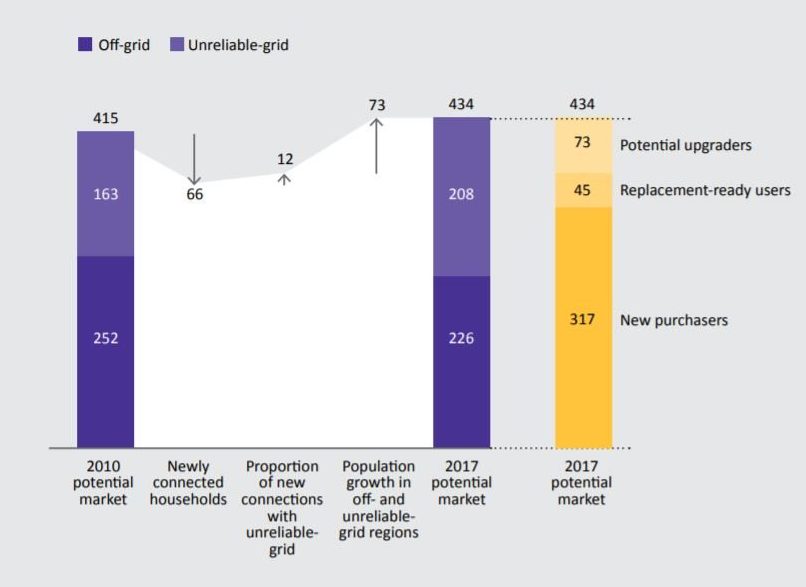
Figure 1 – Change in potential market. Million households (2010-2017 est.).[3]
Impacts of solar products at the end-of-life stage are enormous. Waste photovoltaic panels have serious negative impacts on the environment and on human health, as inappropriate recycling or disposal leads to environmental contamination of hazardous materials. Impacts include leaching of lead, cadmium, and loss of resources including glass, aluminium and rare metals (e.g. silver). Lithium batteries used in solar lanterns are difficult to recycle and lead acid batteries present in solar home systems are often discarded after 5-8 years. Additionally, the volume of e-waste generated is potentially larger than the volume of solar systems themselves, as the demand for consumer electronics and appliances increases with greater access to energy. The disposal of solar products also carries a considerable financial impact on producers and distributors and consequently, on consumers as these costs are often transferred to the end user. According to a study of a European directive, recycling of PV panels is currently not economically viable because waste volumes are too small and significant volumes will only appear in 2025 or 2030 [4].
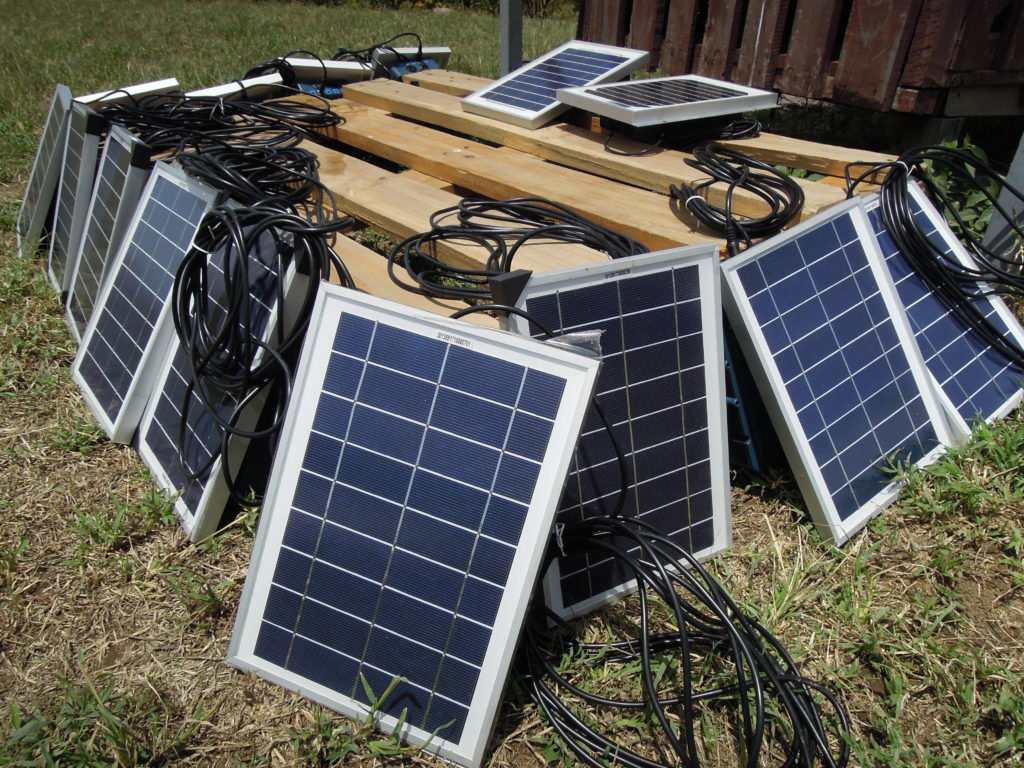
Solar panels production in Kenya [5]
Companies are starting to demonstrate a shift into building e-waste management as part of their policies and business models, while investors are demanding appropriate end-of-life strategies. And yet, barriers at the enabling environment and ecosystem level are limiting these efforts in the sector. One of the main challenges is related to the lack of recycling service providers and appropriate ecosystem to dispose and reuse materials. Another issue is related to inappropriate policy frameworks. India, for example, has set an ambitious target of having 100 GW of solar energy installed by 2022, however waste management systems and manufacturing standards are currently not in place [6]. The consultancy firm Bridge To India (BTI) has estimated solar module waste volume to grow to 1.8 million tonnes by 2050.
In western and mature markets, efforts to extend product lifetimes and to design for environmental sustainability have been in motion for a while. The European Union (EU) already has an Eco-Design Directive 2009; a policy instrument to reduce the environmental impact of energy-related products. Academic research and business innovation produced several successful examples of Product-Service Systems, i.e. sustainable business models characterised by a focus on the sale of ‘performances’ (functional economy) rather than on the sale of physical products (traditional economy). Extending the life of a product in this case becomes embedded in the company’s value proposition, which ‘continuously strives to be competitive, satisfy customer needs and have a lower environmental impact than traditional business models’ [7]. On the other hand, the literature available on the topic of solar e-waste is still nascent. Recent publications include the Lighting Global published several Eco Design Notes on topics relevant to solar e-waste including Battery Toxicity (in 2012), Restriction of Hazardous Substances (in 2013), and Product Repair (in 2017). However, solar companies have been slow in integrating end-of-life strategies as part of their business model, and currently few cases exist in which providers offer energy solution that aim at extending product life cycles.
Advancements in the sector: promising news
While the off-grid sector has experienced a steep growth in recent years, developments of strategies for end-of-life of solar PV panels and related appliances are still nascent. However, as the sector grows, companies, donors and investors have started paying attention to resource efficiency and product life cycles, and particularly to what happens at the end of the product life. Recent examples include the launch of GOGLA’s E-Waste Toolkit, a work-in-progress resource hub developed with funding from Swedfund, which aims at supporting the sector with strategies, financing opportunities and design principles.
The Global LEAP Solar E-Waste Challenge has created a specific call for projects for innovative approaches to e-waste management in the off-grid solar sector in Sub-Saharan Africa, with 1.6 USD million available in grant funding, targeted at recycling and e-waste management companies. The Challenge is an initiative of the Efficiency for Access Coalition supported by the U.S. Agency for International Development (USAID) as part of its commitment to the Scaling Off-Grid Energy (SOGE) Grand Challenge for Development.
Another sign of this recent interest in waste and energy is demonstrated by the focus of the latest Low Carbon Energy for Development Network (UKLCEDN) 8th annual conference which took place earlier in May and addressed energy access and waste. The problem of electric waste and its effects on the growing market of East Africa has just been picked up in a recent NY Times article.
A way forward: strategies and opportunities for the off-grid sector and its funders
The solar sector’s steep growth calls for urgent action for companies, funders and policy makers. In 2016 IRENA and IEA PVPS affirmed that “with the right policies and enabling frameworks in place, the spawning of new industries that recycle and repurpose old solar PV panels will drive considerable economic value creation”. While actions in the enabling environment are crucial to catalyse change in the sector and to ensure that manufacturers and distributors align their intents, below I outline some opportunities that companies and funders can take to extend the life of off-grid solar products:
Technology innovation and product design
Solar products are often designed to have a short life span, as Cross & Murray (2018) [8] affirm “waste is built into solar products by design”. Designing for long-term sustainability means looking at circular design principles and designing products and services with the purpose of extending the products’ life. The Internet of Things (IoT), PAYGo and cloud computing have been helping companies monitor their products better, thus increasing the products’ lifespan, along with its ability to be collected, repaired and reused. A large number of companies such as Mobisol, Bboxx, Off Grid Electric have products with an integrated PAYGo payment mechanism and enjoy a close relationship with their customers, allowing them to remotely monitor performance.
Designing for long-term product sustainability can also entail reusing and refurbishing components. According to Kim et al. (2019) [9], solar systems produced with repurposed lead-acid batteries have a 40% reduction of the environmental burden due to the absence of battery production impacts. Other studies [10] have used Life Cycle Assessments to identify that the environmental impacts of PV installations occur mainly in the manufacturing stage (90% of impact is generated by the mounting structure and inverters) and that domestic production of components and recycling of materials is the best option to reduce emissions from product design and manufacturing.
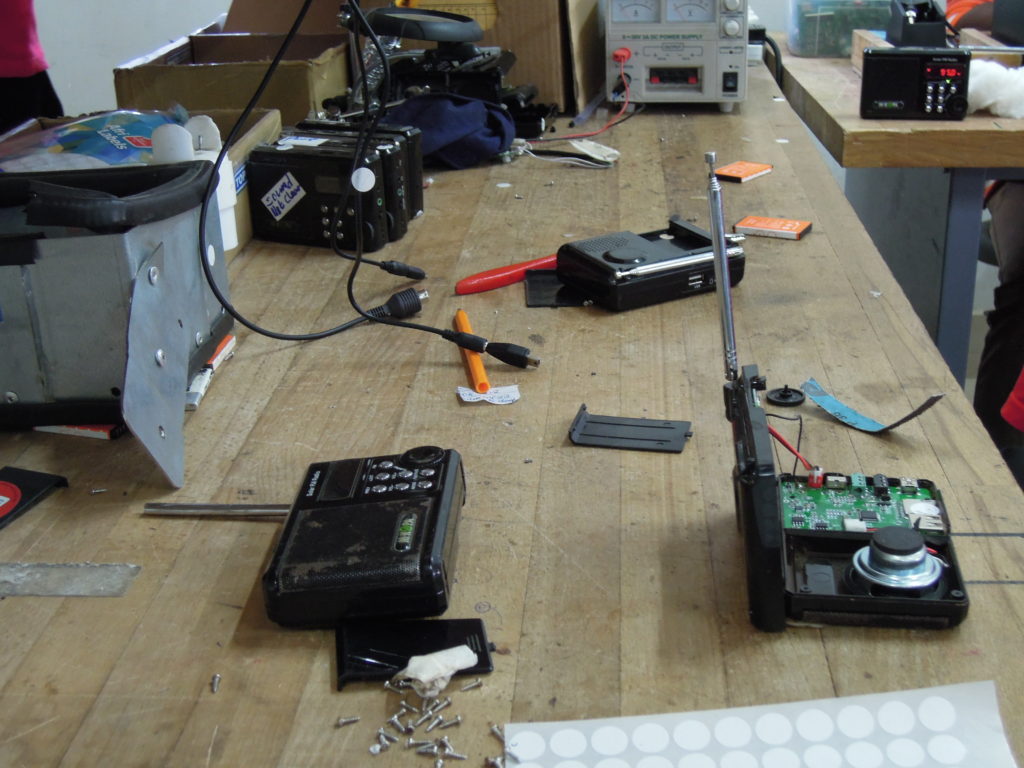
PV panels assembled for solar home systems to be sold in East Africa [11]
Shifting responsibilities from customers to providers
One of the most radical and environmentally sound approaches to ensure that solar products do not get discarded after a short period and that they are appropriately disposed of and recycled involves a shift in the value proposition and business model. Moving away from a sales-based economic model towards a service-based one ensures that responsibilities on the technology and its replacement, refurbishment and disposal are in the hands of the providers. As I’ve argued in my PhD thesis, these types of business models, defined as Product-Service Systems, can provide additional benefits because energy providers would be economically interested in optimising material and energy consumption. In the case of solar technologies, for instance, the producers’ responsibility concerns optimising the energy production of the PV panels, the functionality of their installation and they will be responsible for about 20-year period of product life-cycle. By retaining ownership and responsibilities of products involved in the solution, providers ensure lower environmental impact than traditional business models. In addition, since PSSs are labour and relationship intensive solutions, they can lead to an increase in local employment and dissemination of competences and, eventually, to strengthening the role of local economy.
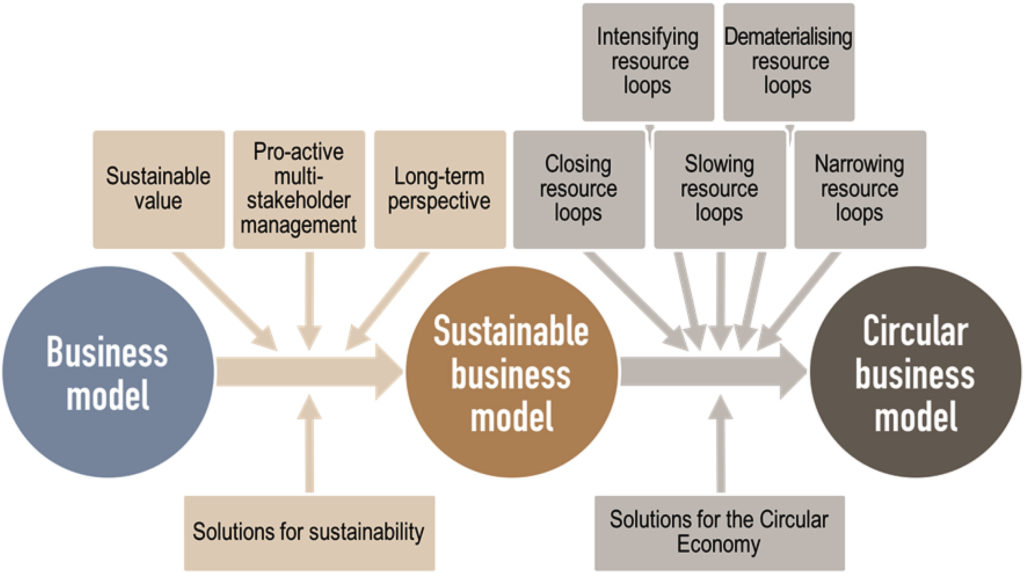
Figure 2 – The shift toward sustainable and circular business models. [12]
Customer awareness and education
Another key element of end-of-life strategies for solar products consists of providing customer education about product use and in order to ensure clear understanding of responsibilities. Energy providers need to ensure that awareness about the technology is built within their service offer, by communicating benefits of products and services and address the lack of familiarity through dedicated user training. Additionally, providers need to take into consideration several aspects of the socio-cultural contexts in where these solutions are implemented, such as customer needs and energy demands, awareness of technology, community organisation and the customer ability to pay. Willingness to pay is in fact directly related to customer awareness, expectations and the perceived value of energy solution. One option is to enhance confidence in the technology through education and training on product use and its benefits.
These strategies represent some entry points to design for long-term environmental sustainability using a systemic approach: from product innovation, to the business model and service offered. Greater opportunities lie in adopting an ecosystem approach and in targeting both regulatory frameworks, demand and supply side of providing solar energy.
At E Co, we have experienced consultants working in the field of circular economy, waste and solar energy. We are actively pursuing opportunities to unlock climate finance in these sectors and we look forward to seeing how applicants and funds will drive the sustainability agenda forward. If you have any questions or projects in these areas, send us an email now to see how we can help – amy@ecoltdgroup.com
Sources
- World Bank/Dalberg, The 2018 Off-Grid Solar Market Trends Report, International Finance Corporation, 2018.
- Magalini, F.; Sinha-Khetriwal, D.; Rochat, D.; Huismann, J.; Munyambu, S.; Oliech, J.; Nnorom, I.C.; Mbera, O. Electronic waste (e-waste) impacts and mitigation options in the off-grid renewable energy sector. Evidence on Demand, UK (2016) ii, 62p Available here.
- World Bank Lighting Global Off-Grid Solar Market
- Study of photovoltaic panels supplementing the impact assessment for a recast of the WEEE directive (2011) Available here.
- Image credit: Dr Silvia Emili
- India needs policy on solar waste management, manufacturing standards: Report. Available here. Accessed 10/05/2019
- Mont O. (2004). Product-service systems: Panacea or myth? PhD thesis, Lund University
- Cross, J. and Murray D. (2018). The afterlives of solar power: Waste and repair off the grid in Kenya. Energy Research & Social Science 44 (2018) 100–109
- Kim et al. (2019). Life cycle assessment for a solar energy system based on reuse components for developing countries. Journal of Cleaner Production vol. 208 Available here.
- Eskew et a. (2018) An environmental Life Cycle Assessment of rooftop solar in Bangkok, Thailand. Renewable Energy vol. 123 Available here.
- Image credit: Dr Silvia Emili
- Geissdoerfer et al. (2018) Sustainable business model innovation: A review. Journal of Cleaner Production 198, p. 401-416
Did you find this article useful? Yes 🙂 No 🙁
Have you read Silvia’s last article on the CTCN Africa Forum and on country-led climate action?
2 Replies
Join the conversation by posting a comment below. You can either use your social account, by clicking on the corresponding icons or simply fill in the form below. All comments are moderated.
Good piece. Even I wonder why governments promote solar as if they come without any environmental footprint. Rather than going for small systems for quick result, I advise to go for a larger system, centralized system. The estimates according to article says that probably only by 2025 would there be sufficient volume of solar waste to operate an economically feasible recycling plant. If all the solar related products are ideally accounted to come to recycling stream, that wont work. But the centralized system would be convenient to link up with the end-of-life recycling.
Thank you for Neelam your comment. I agree with you that solar power should be considered as energy source by taking into account a Life Cycle Assessment and by assessing the cost of extracting resources, manufacturing products, and transporting them across countries or continents. While centralised systems may be more economically sound for some contexts, for other areas that are remote and not densely populated, small distributed systems are probably the most appropriate option both from an environmental and economic point of view. In my opinion, it’s a fine balance between delivering quick results, i.e. providing electricity through small solar systems, and planning for long-term sustainability to ensure that the appropriate ecosystem is in place to dispose products. Governments should integrate regulations for eco design and e-waste in parallel to promoting solar as part of their mitigation and development efforts.